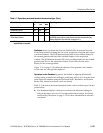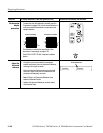
Displaying Waveforms
CSA7000 Series, TDS7000 Series, & TDS6000 Series Instruments User Manual
3- 125
(3) Horizontal-scale readout. For magnified and unmagnified waveforms.
(4) Horizontal reference. A control that you can position to set the point around
which channel waveforms expand and contract horizontally on screen as you
change the Horizontal Scale control or push the ZOOM button. The reference is
also the trigger point when the horizontal delay is 0%.
Touch Screen (not shown). A feature that lets you touch on-screen controls or
touch and drag screen objects to operate the instrument.
Some features of the display follow:
H Flexible Display Control. Front-panel knobs and buttons support quick
access to the most often used adjustments — those that display, position, and
scale waveforms. Mouse, keyboard, and touch-screen interfaces support
complete setup of all the display parameters. Anything you can do with the
mouse, you can do with the touch screen.
H Fast Access to Zoom. Waveform inspection has never been easier. Just touch
and drag a box around the feature of interest and select zoom from the
choices offered, and the feature of interest displays zoomed in the magnified
graticule. Both vertical and horizontal zoom functions are available. Zoomed
waveforms can be aligned, locked, and automatically scrolled.
H Acquisition Preview. When the next acquisition is delayed due to slow
triggers or long acquisition duration, acquisition preview attempts to show
what the next acquisition will look like. Acquisition preview does not
recalculate math waveforms or represent changes in trigger levels, trigger
modes, or different acquisition modes. Acquisition preview waveforms can’t
be saved as data.
Read the following topics; they provide the details that can help you set up the
instrument display so that it best supports your data-analysis tasks.
Waveform Display. In general, the method of displaying a waveform is to define
the waveform, if necessary (math and reference waveforms), and then turn it on.
Table 3--6 summarizes this process as it applies to the different waveforms.
Using the Display


















